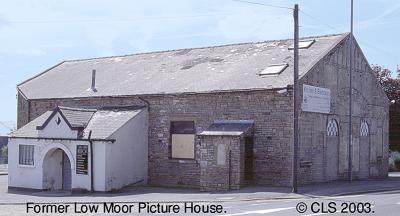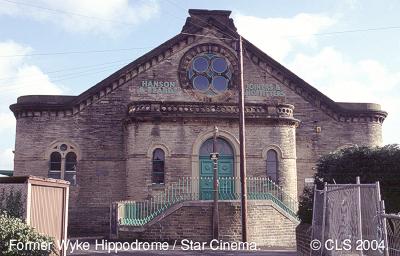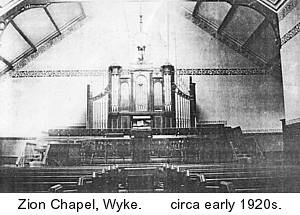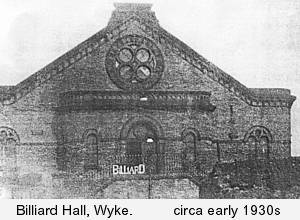Quick links to Low Moor Picture House
and Wyke Hippodrome / Star.
Low Moor Picture House
Bolton Street / Huddersfield Road,
Low Moor,
Bradford.
 Quick links to other sections on this page . . .
Quick links to other sections on this page . . .

Location & Building
A single story building formerly the Brotherhood Mission Hall and converted into a single-deck cinema with 538 seats arranged in three blocks with two aisles. The front two rows were long forms with a distance of 12ft 9inches to the wall mounted screen whilst the side blocks had their seats angled towards the screen. Original proprietors were J.B Simpson and John Lush who was also its resident manager. John Lush was also involved with the Kozey Picture Hall at Thornbury and later became sole proprietor at Low Moor before his sons Austin and George took control.
Although the building fronted onto the east side of the main Huddersfield Road, its main entrance as a cinema was at the side in Bolton Street. Very little has been documented about this building.

Opening
The Low Moor Picture House opened on Monday 14th September 1914 with an all silent programme which included the latest war (First World War) pictures and a serial. The war pictures were the forerunner of the cinema newsreel and the cliffhanger endings of serials were to get you to come back the following week. A lady pianist accompanied those early films. Shows were twice nightly but in the mid-1920's changed to once nightly and two performances on Saturdays for the rest of its duration.
In the later silent years music was provided by Arthur Butterworth on violin and John on piano plus sound effects. Norman Littlewood, a former projectionist recalls how he used to wind the proscenium curtains by hand at the start and end of each performance. His cue to open the curtains was a small spot of light projected on to the drapes as the film was started.
Some small competition was to arrive with opening in 1926 of the Wyke Hippodrome down the road in Wyke Village.
The British Thompson Houston (BTH) sound system was added in 1931 to the BTH projectors and seating reduced to 526 and later down to 490. The cinema continued successfully through the Second World War and early 1950's.

Closure
Low Moor Picture House joined many others with falling attendances and competition from TV (albeit only two channels) and closed on Saturday 15th June 1957 with the special Whitsuntide attraction:
"Reap the Wild Wind" - 1942 USA Technicolor 124 mins
Starring Ray Milland, John Wayne and Paulette Goddard.

Re-opens for Bingo
After a period of disuse the premises then re-opened in 1964 as the Pelican Bingo Club and lasted until 1983.

Commercial Use
The building still exists (in 2004) and owned by Nigel Turner trading as Orrell-Turner Interiors manufacturing bedrooms and kitchens whose address 'The Old Picture House' acknowledges the previous use of the building.
Another occupant of the old cinema building is AZTEC French Polishers whose advert in Yellow Pages gives the address as 'Pelican Picture House' - obviously some confusion regarding the former name as 'Pelican' referred only to the Bingo operation and never to the picture house. Kinematograph trade records show none other than Low Moor Picture House as the correct name.

Wyke Hippodrome / Star
Garden Field,
Wyke,
Bradford.
 Quick links to other sections on this page . . .
Quick links to other sections on this page . . .

Location & Building
 A quite impressive solid stone building once the former Wyke Zion Congregational Chapel built in 1885 at a cost of just over £2000. It is set back from Towngate, the main road through the old Wyke village, making it quite easy to miss nowadays when driving past.
A quite impressive solid stone building once the former Wyke Zion Congregational Chapel built in 1885 at a cost of just over £2000. It is set back from Towngate, the main road through the old Wyke village, making it quite easy to miss nowadays when driving past.

Conversion to Cinema
The disused chapel was converted into a single-deck silent picture hall with 696 seats (later reduced to 580) by John Lambert of Leeds in 1926. The elevated central entrance was reached by either of two sets of stone steps meeting at a central landing supporting a wrought iron balustrade. The hall at circa 67feet wide was wider than its length particularly after the proscenium was added. Seating was arranged in three blocks with two aisles; the front part of the side blocks had its seats angled towards the screen whilst the remainder were straight across. Its proscenium opening was 20 feet.
The Wyke Hippodrome, as it was to be known, opened with Joseph Holroyd as manager on Saturday 4th September 1926 advertising "The Pick of the Pictures". The silent films were accompanied by a piano as Wyke did not aspire to the cinema orchestras of some other picture houses surrounding Bradford. The nearest 'competition' was the much older Low Moor Picture House in Huddersfield Road.

Closure & Change of Use
 The coming of "talkies" in other larger halls from 1929 and the costs of its installation were such that the Hippodrome closed down in 1931. The building was then used as a billiard hall for several years.
The coming of "talkies" in other larger halls from 1929 and the costs of its installation were such that the Hippodrome closed down in 1931. The building was then used as a billiard hall for several years.

Re-opened with Sound
In 1937 the Hippodrome re-opened again as a "talkie" cinema with the installation of the BTH (British Thompson Houston) Sound System installed on two Ross projectors. Seating capacity was now reduced to 517. A proscenium with curtains was built to accommodate the screen and loudspeaker.
The re-opening programme on Monday 4th January 1937 had the main feature . . .
"Ball at the Savoy" - 1936 UK B/W
(aka "With Pleasure Madame" in USA)
Starring Conrad Nagel, Marta Labarr and Lu Ann Meredith.
plus
"Seven Keys to Baldpate" - 1935 USA B/W
Starring Gene Raymond, Margaret Callahan and Eric Blore.
Manager was Harold Mallinson.
The Hippodrome was now under the control of Uni-Cinemas of Mill Hill in Leeds also run by John S. Lambert. Around the same time Lambert, trading under the name of Modern Theatres, also controlled the much newer Regal cinema (former Palladium) at Five Lane Ends near Eccleshill. In the late 1940s prices were 6d to 1/-d with two shows nightly.

New Name
By 1950 it underwent a refurbishment and changing its name to Wyke Star. Typical of suburban village cinemas, its programmes were now changed three times a week. Prices were now 7d to 1/3d. The new seating was arranged in four blocks of 16 rows with three (centre) aisles and a feature was the inclusion of double 'love' seats nearest the walls which were popular with courting couples.
Its manager was now Alfred Ashington- a former projectionist at several Bradford and Shipley cinemas and a descendant of fairground showman Harry Ashington who had a Marionette show and film show billed as 'Ashington's Portable Pavilion' at the Holbeck Feast back in 1897.
Alf Ashington recalls that behind the Wyke screen there were still scriptures on the walls from its early chapel days. After his retirement, Alf Ashington found a new vocation giving humorous talks on his life working in cinemas and also providing dance music as "Alf's Tempo Tunes". He died in July 2009 at the age of 85.
A widescreen was fitted around 1954 but there is no record of true CinemaScope being installed.

Fire & Closure
The Wyke Star was put up for auction as a going concern on 14th May 1958. The owners, Uni Cinemas Ltd, had decided that because of falling attendances the cinema was no longer viable. Pentland Hick Cinemas of Scarborough took over its running.
[Pentland Hick had a small chain of seven cinemas with HQ at the Gaiety Cinema, Scarborough. In 1959 Hick sold his cinema chain and pioneered the Flamingo Land Theme Park and Zoo.]
The Wyke Star closed abruptly on Thursday 26th February 1959 due to a fire in which the small stage/proscenium, screen, loudspeaker and a piano were destroyed.
The last films shown were . . .
"The Tall 'T'" - 1957 USA Technicolor 78 mins.
Starring Randolph Scott, Richard Boone and Maureen O'Sullivan.
and
"Crash Landing" - 1958 USA B/W 76 mins.
Starring Gary Merrill, Nancy Davis and Irene Hervey.
The nearest cinema, Low Moor Picture House in Huddersfield Road had already closed in 1957 and the Wyke Star was the last surviving cinema in this southern outpost of Bradford.

An Afterlife
The premises were stripped of all their cinema trappings and were adapted for commercial purposes with several occupancies over the years.
In recent years it has been occupied by Hanson & Beards Ltd, joiners and shopfitters who renamed the former chapel/cinema building to 'Victory Works'. In 2010 the building was on the market for sale/rent with planning permission for conversion to 15 apartments. In 1885 it cost £2,000 to build and in 2010 its market price is around £300,000.

Copyright ©2004, Colin Sutton.
May not be copied or reproduced without permission.

Return to Bradford Cinemas History Index Page.
| 

 A quite impressive solid stone building once the former Wyke Zion Congregational Chapel built in 1885 at a cost of just over £2000. It is set back from Towngate, the main road through the old Wyke village, making it quite easy to miss nowadays when driving past.
A quite impressive solid stone building once the former Wyke Zion Congregational Chapel built in 1885 at a cost of just over £2000. It is set back from Towngate, the main road through the old Wyke village, making it quite easy to miss nowadays when driving past. The coming of "talkies" in other larger halls from 1929 and the costs of its installation were such that the Hippodrome closed down in 1931. The building was then used as a billiard hall for several years.
The coming of "talkies" in other larger halls from 1929 and the costs of its installation were such that the Hippodrome closed down in 1931. The building was then used as a billiard hall for several years.